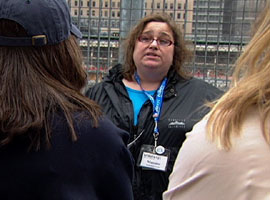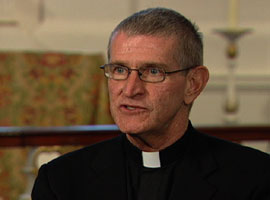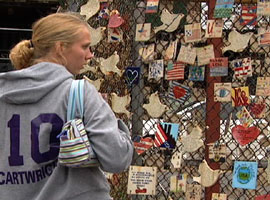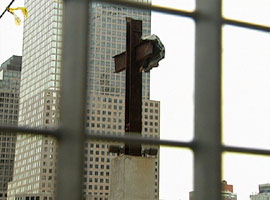In This Episode << SLIDE LEFT TO SEE ADDITIONAL SEGMENTS
9/11 Five Year Anniversary
BOB ABERNETHY, anchor: The enduring symbol of [the 9/11] terrorist attacks is Ground Zero in New York. Thousands of people every week are still visiting the site where the World Trade Center once stood. But five years since 9/11, Lucky Severson says, there’s still so much traffic and construction and so much controversy about how to rebuild that it’s hard to feel Ground Zero as sacred space.
LUCKY SEVERSON: There’s a constant flow of tour buses — people trying to comprehend. Some come to pay respect, to share grief. But for many this is just another spot on the tour map, something that happened five years ago. Time, for some, has dimmed the magnitude of what was lost here, and it seems that the building owners, the city and state cannot agree on what would honor this sacred space.
While the sides bicker over a permanent memorial site, people from all over the world come to this spot that offers little more than an overview of construction activity. It is not an easy place to make a connection to what happened here. The construction site is noisy. Commuters on their way to the underground train station bustle through the overview plaza, where about all that can be seen are pictures of before, during, and after.
 Maxine Laboy escaped from the 17th floor of Tower Two. She survived but suffered a nervous breakdown. Now she volunteers as a tour guide who hopes to help volunteers feel the significance of this place.
Maxine Laboy escaped from the 17th floor of Tower Two. She survived but suffered a nervous breakdown. Now she volunteers as a tour guide who hopes to help volunteers feel the significance of this place.
MAXINE LABOY (Tour Guide): There really is nothing down here. That’s why we do these tours, because we realize there are so many people that come down here, and a good majority of them are looking for something to connect to, and there really isn’t anything.
SEVERSON: There is the powerful image of a cross standing among the debris, but it’s been set off to the side, and many people miss it.
Ms. LABOY: I do think there are people who come just because it’s like the thing to see, and they treat it a little bit like the Statue of Liberty or Disney World, and they stand out front and take pictures and say, “Look, I was here.” But the people who come on the tours, however, in my experience, have all been people trying to connect with it and understand it a little bit more on a personal level. So for those people it’s more of a pilgrimage.
SEVERSON: For thousands of visitors, the place that symbolizes the courage and kinship that put New York back together is St. Paul’s (Episcopal) Chapel. Once it was in the shadow of the towers, and then for months a 24-hour a day command center and sanctuary for firemen, rescue and construction workers.
 REV. STUART HOKE (St. Paul’s Chapel): It appears that our higher power had a place, had a mission for this institution.
REV. STUART HOKE (St. Paul’s Chapel): It appears that our higher power had a place, had a mission for this institution.
SEVERSON: Over 1700 days later, the chapel continues to comfort many hundreds each day. The Reverend Stuart Hoke, pastor of St. Paul’s, watched the second plane crash into Tower Two and then helped rescue kids from a day care center.
Rev. HOKE: There is no shrine, there is no memorial at Ground Zero. The city has not provided that or the state. This, ipso facto, has become the holy place. Many come as pilgrims. I mean they are intentional about visiting a holy place, which is what a pilgrim is. They come, first of all, and you can see them sit down in the pews and then they weep and they pay their respects to the blessed dead, and they mourn their losses, whatever those losses are.
SEVERSON: Reverend Hoke notes proudly that St. Paul’s has possibly become the most visited church in the United States.
Rev. HOKE: We thought that within the first year the wave of curiosity seekers and pilgrims, whatever they are, would have completely fallen off. We were astounded after the first year the numbers — they increased the second year. This year has been the highest number ever. We now have 35 to 40,000 people a week. We’ve had 3 million — over 3 million people in this building since the first anniversary of 9/11.
SEVERSON: For first timers, Ground Zero is often a jarring experience.
 SAM CHEEK (Visitor from South Carolina): We live in a very safe community in South Carolina, and we have forgotten what happened here, and so we need to come back so we can continue to keep it fresh in our memory.
SAM CHEEK (Visitor from South Carolina): We live in a very safe community in South Carolina, and we have forgotten what happened here, and so we need to come back so we can continue to keep it fresh in our memory.
SEAMUS REYNOLDS (Visitor from Ireland): When you come to New York, the Statue of Liberty symbolizes what America meant to be all about. This is, what, the American dream meeting the kind of nightmare, if you will, and I mean something very horrible happened, and you kind of have to see both.
SEVERSON: Immediately after the terror attack, there were dozens of memorials in the city. Now only a few, like this tile fence, have endured. Steve Zeitlin is executive director of City Lore.
STEVE ZEITLIN (Executive Director, City Lore): The more this event becomes the pivotal event of the 21st century the more people want to be a part of it and connect to it in some meaningful way. They want to go to those places, and they want to feel something that connects them to that moment.
SEVERSON: Foreigners come to places like Battery Park, where there is a mangled exhibit that was once a Twin Towers sculpture dedicated to world peace. Now a flame burns near it for the victims of 9/11. And then there is the sculpture on the wall of the fire station honoring the nearly 350 firemen who were killed. From the American visitors we heard resolve.
 LINDA BALLING (Visitor from California): We need to come and remember and stand tall for America.
LINDA BALLING (Visitor from California): We need to come and remember and stand tall for America.
CHRISTOPHER GLENN (Visitor from Washington): The positive out of it is that you can come to a place like this. You can look around, and you can see that people are genuinely concerned about what has taken place and kind of want to shoulder that burden of tragedy.
SEVERSON: Reverend Hoke says visitors often leave St. Paul’s with a sense of hope that he believes is desperately needed.
Rev. HOKE: You cannot imagine how people write us and say, “I was transformed by these experiences at St. Paul’s, and let me tell you why,” and that word “hope” is invariably mentioned somewhere. It looks right now like we are desperate for senses of hope everywhere.
SEVERSON: However much New Yorkers have healed in the time gone by, the city still has an open wound — the temporary morgue storing unidentified body parts which have also been found in the soon to be demolished Deutsche Bank building. There is still so much unsettled. Steve Zeitlin says New Yorkers more than anyone need a permanent memorial.
Steve ZEITLIN: They want something that is artful and beautiful and that can be a place for contemplation and be a place where they can think about what happened and try to touch what happened and move forward in a great way from it.
SEVERSON: Zeitlin believes that moving forward can occur only when all sides can agree on a suitable way to honor the dead and this sacred space.
For RELIGION & ETHICS NEWSWEEKLY, I’m Lucky Severson in New York.
ABERNETHY: A recent NEW YORK TIMES-CBS News poll found that nearly a third of New Yorkers said they still think about Sept. 11 every single day.

